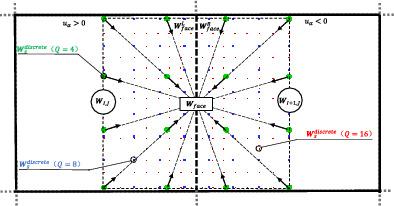当前位置:
X-MOL 学术
›
Int. J. Numer. Methods Fluids
›
论文详情
Our official English website, www.x-mol.net, welcomes your feedback! (Note: you will need to create a separate account there.)
A novel gas kinetic flux solver for simulation of continuum and slip flows
International Journal for Numerical Methods in Fluids ( IF 1.8 ) Pub Date : 2021-05-17 , DOI: 10.1002/fld.5013 Zhenyu Yuan 1 , Liming Yang 2 , Chang Shu 1 , Zijian Liu 1 , Wei Liu 1
International Journal for Numerical Methods in Fluids ( IF 1.8 ) Pub Date : 2021-05-17 , DOI: 10.1002/fld.5013 Zhenyu Yuan 1 , Liming Yang 2 , Chang Shu 1 , Zijian Liu 1 , Wei Liu 1
Affiliation

|
In this work, a novel gas kinetic flux solver (GKFS) is presented for simulation of compressible and incompressible flows in the continuum and slip regimes. The finite volume method is adopted to discretize the governing differential equations, and inviscid and viscous fluxes at the cell interface are evaluated simultaneously by the local solution to the Boltzmann equation. Different from the conventional GKFS, in which the local solution to the Boltzmann equation is divided into the equilibrium part and the nonequilibrium part and the nonequilibrium distribution function is approximated by the difference of equilibrium distribution functions at the cell interface and its surrounding points, the present solver evaluates the local solution by integrating the Boltzmann equation along the characteristic line. As a result, the local solution to the Boltzmann equation consists of the equilibrium distribution function at the cell interface and the initial distribution function at the surrounding points. In the present work, the initial distribution function is given from the first-order Chapman–Enskog expansion. Finally, the distribution function at the cell interface is only relevant to the macroscopic variables and their spatial derivatives. Accordingly, the fluxes across the cell interface can be evaluated by the moments of the distribution function at the cell interface. Test results show that the present solver can provide accurate numerical predictions for flows in both continuum and slip regimes.
中文翻译:

一种用于模拟连续流和滑移的新型气体动力学通量求解器
在这项工作中,提出了一种新颖的气体动力学通量求解器 (GKFS),用于模拟连续介质和滑移状态中的可压缩和不可压缩流动。采用有限体积法对控制微分方程进行离散化,并通过玻尔兹曼方程的局部解同时计算单元界面处的无粘性和粘性通量。不同于传统的 GKFS,将玻尔兹曼方程的局部解分为平衡部分和非平衡部分,非平衡分布函数近似于单元界面及其周围点的平衡分布函数的差异,现在求解器通过沿特征线对 Boltzmann 方程进行积分来评估局部解。因此,玻尔兹曼方程的局部解由单元界面处的平衡分布函数和周围点处的初始分布函数组成。在目前的工作中,初始分布函数由一阶 Chapman-Enskog 展开给出。最后,单元界面的分布函数只与宏观变量及其空间导数有关。因此,跨单元界面的通量可以通过单元界面处的分布函数的矩来评估。测试结果表明,本求解器可以为连续介质和滑移状态下的流动提供准确的数值预测。在目前的工作中,初始分布函数由一阶 Chapman-Enskog 展开给出。最后,单元界面的分布函数只与宏观变量及其空间导数有关。因此,跨单元界面的通量可以通过单元界面处的分布函数的矩来评估。测试结果表明,本求解器可以为连续介质和滑移状态下的流动提供准确的数值预测。在目前的工作中,初始分布函数由一阶 Chapman-Enskog 展开给出。最后,单元界面的分布函数只与宏观变量及其空间导数有关。因此,跨单元界面的通量可以通过单元界面处的分布函数的矩来评估。测试结果表明,本求解器可以为连续介质和滑移状态下的流动提供准确的数值预测。跨单元界面的通量可以通过单元界面处分布函数的矩来评估。测试结果表明,本求解器可以为连续介质和滑移状态下的流动提供准确的数值预测。跨单元界面的通量可以通过单元界面处分布函数的矩来评估。测试结果表明,本求解器可以为连续介质和滑移状态下的流动提供准确的数值预测。
更新日期:2021-05-17
中文翻译:

一种用于模拟连续流和滑移的新型气体动力学通量求解器
在这项工作中,提出了一种新颖的气体动力学通量求解器 (GKFS),用于模拟连续介质和滑移状态中的可压缩和不可压缩流动。采用有限体积法对控制微分方程进行离散化,并通过玻尔兹曼方程的局部解同时计算单元界面处的无粘性和粘性通量。不同于传统的 GKFS,将玻尔兹曼方程的局部解分为平衡部分和非平衡部分,非平衡分布函数近似于单元界面及其周围点的平衡分布函数的差异,现在求解器通过沿特征线对 Boltzmann 方程进行积分来评估局部解。因此,玻尔兹曼方程的局部解由单元界面处的平衡分布函数和周围点处的初始分布函数组成。在目前的工作中,初始分布函数由一阶 Chapman-Enskog 展开给出。最后,单元界面的分布函数只与宏观变量及其空间导数有关。因此,跨单元界面的通量可以通过单元界面处的分布函数的矩来评估。测试结果表明,本求解器可以为连续介质和滑移状态下的流动提供准确的数值预测。在目前的工作中,初始分布函数由一阶 Chapman-Enskog 展开给出。最后,单元界面的分布函数只与宏观变量及其空间导数有关。因此,跨单元界面的通量可以通过单元界面处的分布函数的矩来评估。测试结果表明,本求解器可以为连续介质和滑移状态下的流动提供准确的数值预测。在目前的工作中,初始分布函数由一阶 Chapman-Enskog 展开给出。最后,单元界面的分布函数只与宏观变量及其空间导数有关。因此,跨单元界面的通量可以通过单元界面处的分布函数的矩来评估。测试结果表明,本求解器可以为连续介质和滑移状态下的流动提供准确的数值预测。跨单元界面的通量可以通过单元界面处分布函数的矩来评估。测试结果表明,本求解器可以为连续介质和滑移状态下的流动提供准确的数值预测。跨单元界面的通量可以通过单元界面处分布函数的矩来评估。测试结果表明,本求解器可以为连续介质和滑移状态下的流动提供准确的数值预测。



























 京公网安备 11010802027423号
京公网安备 11010802027423号